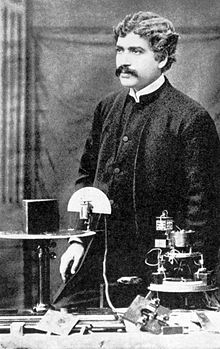
Back डा (सर) जगदीश चन्द्र बोस ANP جاجاديش تشاندرا بوس Arabic جاجاديش تشاندرا بوس ARZ জগদীশ চন্দ্ৰ বসু Assamese डा. जगदीश चन्द्र बोस AWA جاقادیش چاندرا بوس AZB জগদীশ চন্দ্র বসু Bengali/Bangla Džagadíščandra Bose Czech Jagadish Chandra Bose German डा. जगदीश चन्द्र बोस DTY
Jagadish Chandra Bose | |
|---|---|
 Jagadish Chandra Bose in 1897 | |
| Born | 30 November 1858 |
| Died | 23 November 1937 (aged 78) Giridih, British India |
| Alma mater | St. Xavier's College, Calcutta (BA) Christ's College, Cambridge (BA) University College London (BSc, DSc) |
| Known for | Microwave radio research Crystal detector Crescograph Contributions to botany |
| Spouse | Abala Bose |
| Awards | Companion of The Order of the Indian Empire (CIE) (1903) Companion of the Order of the Star of India (CSI) (1911) Knight Bachelor (1917) |
| Scientific career | |
| Fields | Physics, biophysics, biology, botany |
| Institutions | |
| Academic advisors | John Strutt (Rayleigh) |
| Notable students | Satyendra Nath Bose Meghnad Saha Prasanta Chandra Mahalanobis Sisir Kumar Mitra Debendra Mohan Bose |
| Signature | |
Sir Jagadish Chandra Bose[1] CSI CIE FRS[2][3][4] (/boʊs/;[5] IPA: [dʒɔɡodiʃ tʃɔndro boʃu]; 30 November 1858 – 23 November 1937)[6] was a polymath with interests in biology, physics, botany and writing science fiction.[7] He was a pioneer in the investigation of radio microwave optics, made significant contributions to botany, and was a major force behind the expansion of experimental science on the Indian subcontinent.[8] Bose is considered the father of Bengali science fiction. A crater on the Moon was named in his honour.[9] He founded the Bose Institute, a premier research institute in India and also one of its oldest. Established in 1917, the institute was the first interdisciplinary research centre in Asia.[10] He served as the Director of Bose Institute from its inception until his death.
Born in Mymensingh, Bengal Presidency (present-day Bangladesh), during British governance of India,[6] Bose graduated from St. Xavier's College, Calcutta (now Kolkata, West Bengal, India). Prior to his enrollment at St. Xavier's College, Calcutta, Bose attended Dhaka Collegiate School, where he began his educational journey. He attended the University of London to study medicine, but had to give it up due to health problems. Instead, he conducted research with Nobel Laureate, Lord Rayleigh at the University of Cambridge. Bose returned to India to join the Presidency College of the University of Calcutta as a professor of physics. There, despite racial discrimination and a lack of funding and equipment, Bose carried on his scientific research. He made progress in his research into radio waves in the microwave spectrum and was the first to use semiconductor junctions to detect radio waves.
Bose made pioneering discoveries in plant physiology. He used his own invention, the crescograph, to measure plant response to various stimuli and proved parallelism between animal and plant tissues. Bose filed for a patent for one of his inventions because of peer pressure, but he was generally critical of the patent system. To facilitate his research, he constructed automatic recorders capable of registering extremely slight movements; these instruments produced some striking results, such as quivering of injured plants, which Bose interpreted as a power of feeling in plants. His books include Response in the Living and Non-Living (1902) and The Nervous Mechanism of Plants (1926). He spent the last years of his life in Giridih. Here he lived in the house located near Jhanda Maidan. This building was named Jagdish Chandra Bose Smriti Vigyan Bhavan. It was inaugurated on 28 February 1997 by then Governor of Bihar AR Kidwai. In a 2004 BBC poll to name the Greatest Bengali of all time, Bose placed seventh.[11]
- ^ Page 3597 of Issue 30022. The London Gazette (17 April 1917). Retrieved 1 September 2010.
- ^ Page 9359 of Issue 28559. The London Gazette (8 December 1911). Retrieved 1 September 2010.
- ^ Page 4 of Issue 27511. The London Gazette (30 December 1902). Retrieved 1 September 2010.
- ^ Saha, M. N. (1940). "Sir Jagadis Chunder Bose. 1858–1937". Obituary Notices of Fellows of the Royal Society. 3 (8): 2–12. doi:10.1098/rsbm.1940.0001. S2CID 176697911.
- ^ "Bose". Random House Webster's Unabridged Dictionary.
- ^ a b Editorial Board (2013). Sir Jagdish Chandra Bose. Edinburgh, Scotland: Encyclopædia Britannica, Inc. ISBN 978-1-59339-292-5.
- ^ "A versatile genius". Frontline. Vol. 21, no. 24. The Hindu. 20 November 2004.
- ^ Chatterjee, Santimay; Chatterjee, Enakshi (1976). Satyendra Nath Bose. New Delhi: National Book Trust. p. 6. OCLC 3017431.
- ^ Bose (crater)
- ^ "Bose Institute | History". jcbose.ac.in. Retrieved 29 July 2020.
- ^ Cite error: The named reference
ISB1was invoked but never defined (see the help page).
© MMXXIII Rich X Search. We shall prevail. All rights reserved. Rich X Search